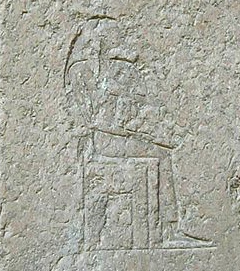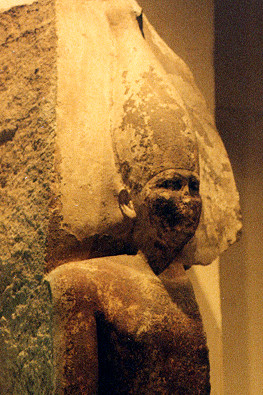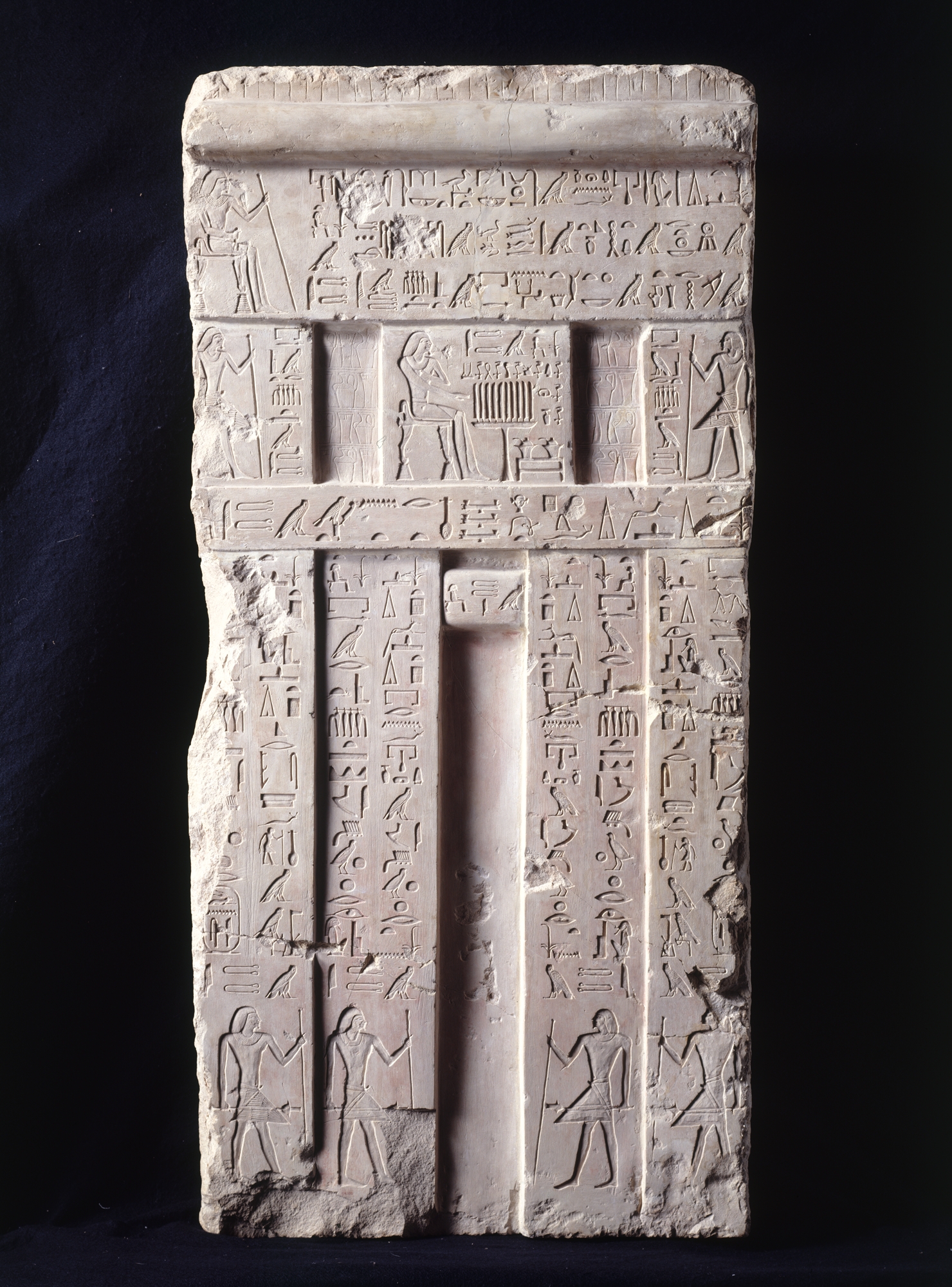|
Menkaura
Menkaure or Menkaura (; 2550 BC - 2503 BC) was a king of the Fourth Dynasty of Egypt during the Old Kingdom. He is well known under his Hellenized names Mykerinos ( by Herodotus), in turn Latinized as Mycerinus, and Menkheres ( by Manetho). According to Manetho, he was the throne successor of king Bikheris, but according to archaeological evidence, he was almost certainly the successor of Khafre. Africanus (from Syncellus) reports as rulers of the fourth dynasty Sôris, Suphis I, Suphis II, Mencherês (=Menkaure), Ratoisês, Bicheris, Sebercherês, and Thamphthis in this order. Menkaure became famous for his tomb, the Pyramid of Menkaure, at Giza and his statue triads, which showed him alongside the goddess Hathor and various regional deities. Family Menkaure was the son of Khafre and the grandson of Khufu. A flint knife found in the mortuary temple of Menkaure mentioned a king's mother Khamerernebty I, suggesting that Khafre and this queen were the parents of Menkaure. ... [...More Info...] [...Related Items...] OR: [Wikipedia] [Google] [Baidu] |
Khufu
Khufu or Cheops (died 2566 BC) was an ancient Egyptian monarch who was the second pharaoh of the Fourth Dynasty of Egypt, Fourth Dynasty, in the first half of the Old Kingdom of Egypt, Old Kingdom period (26th century BC). Khufu succeeded his father Sneferu as king. He is generally accepted as having commissioned the Great Pyramid of Giza, one of the Seven Wonders of the Ancient World, but many other aspects of his reign are poorly documented.Thomas Schneider: ''Lexikon der Pharaonen''. Albatros, Düsseldorf 2002, , page 100–104. The only completely preserved portrait of the king is a Khufu Statuette, small ivory figurine found in a temple ruin of a later period at Abydos, Egypt, Abydos in 1903. All other reliefs and statues were found in fragments, and many buildings of Khufu are lost. Everything known about Khufu comes from inscriptions in his necropolis at Giza pyramid complex, Giza and later documents. For example, Khufu is the main character noted in the Westcar Papyrus ... [...More Info...] [...Related Items...] OR: [Wikipedia] [Google] [Baidu] |
Thamphthis
Thamphthis ( c. 2500 BC) is the hellenized name of an ancient Egyptian ruler (pharaoh) of the 4th Dynasty in the Old Kingdom, who may have ruled under the name Djedefptah or Djedefkaf for between two and nine years. His original Egyptian name is lost, but it may have been ''Djedefptah'' ("he endures like Ptah") according to Egyptologists like William C. Hayes, or ''Djedefkaf'' ("his Ka is enduring") according to other Egyptologists. Thamphthis is one of the shadowy rulers of the Old Kingdom, since he is completely unattested in contemporary sources. For this reason, his historical figure is discussed intensely by historians and Egyptologists. Background Since Thamphthis' name was found in the historical works of Manetho, the ''Aegyptiacae'',William Gillian Waddell: ''Manetho (The Loeb classical library 350)''. pp. 47–49 Egyptologists are trying to connect this ruler with contemporary kings to build up a continuous chronology, which resulted in controversies and debates. As ... [...More Info...] [...Related Items...] OR: [Wikipedia] [Google] [Baidu] |
Shepseskaf
Shepseskaf (meaning "His Ka is noble") was a pharaoh of ancient Egypt, the sixth and probably last ruler of the fourth dynasty during the Old Kingdom period. He reigned most probably for four but possibly up to seven years in the late 26th to mid-25th century BC. Shepseskaf's relation to his predecessor Menkaure is not entirely certain; he might have been his son or possibly his brother. The identity of his mother is highly uncertain as she could have been one of Menkaure's consorts or queen Khentkaus I or Neferhetepes. Similarly, Shepseskaf's relation to his probable successor on the throne, Userkaf, is not known although in the absence of clear indication of strife at the transition between the fourth and fifth dynasties, Userkaf could well have been his son or his brother. If Shepseskaf was succeeded directly by Userkaf rather than by Thampthis as claimed by some historical sources, then his death marks the end of the fourth dynasty. The transition to the fifth dyna ... [...More Info...] [...Related Items...] OR: [Wikipedia] [Google] [Baidu] |
Fourth Dynasty Of Egypt
The Fourth Dynasty of ancient Egypt (notated Dynasty IV) is characterized as a "golden age" of the Old Kingdom of Egypt. Dynasty IV lasted from to c. 2498 BC. It was a time of peace and prosperity as well as one during which trade with other countries is officially documented. The Fourth Dynasty heralded the height of the pyramid-building age. The peaceful rule of the Third Dynasty of Egypt, Third Dynasty allowed artistic expressions to flourish. Building experiments done by King Sneferu led to the evolution of mastaba tombs into the smooth sided pyramids like those seen on the Giza Plateau. No other period in Egyptian history equaled the accomplishments achieved during the Fourth Dynasty.Egypt: Land and Lives of the Pharaohs Revealed, (2005), pp. 80–90, Global Book Publishing: Australia Rulers Summary of Listed Kings Sneferu Sneferu, lauded as "Bringer of Beauty", "Master of All Justice", and "Ruler of Lower and Upper Nile", was the first pharaoh of the fourt ... [...More Info...] [...Related Items...] OR: [Wikipedia] [Google] [Baidu] |
Old Kingdom Of Egypt
In ancient Egyptian history, the Old Kingdom is the period spanning –2200 BC. It is also known as the "Age of the Pyramids" or the "Age of the Pyramid Builders", as it encompasses the reigns of the great pyramid-builders of the Fourth Dynasty of Egypt, Fourth Dynasty, such as King Sneferu, under whom the art of pyramid-building was perfected, and the kings Khufu, Khafre and Menkaure, who commissioned the construction of the Giza pyramid complex, pyramids at Giza. Ancient Egypt, Egypt attained its first sustained peak of civilization during the Old Kingdom, the first of three so-called "Kingdom" Egyptian chronology, periods (followed by the Middle Kingdom of Egypt, Middle Kingdom and New Kingdom of Egypt, New Kingdom), which mark the high points of civilization in the lower Nile Valley. The Periodization of Ancient Egypt, concept of an "Old Kingdom" as one of three "golden ages" was coined in 1845 by the German Egyptology, Egyptologist Christian Charles Josias von Bunsen, Baron ... [...More Info...] [...Related Items...] OR: [Wikipedia] [Google] [Baidu] |
Khamerernebty I
Khamerernebty I was an ancient Egyptian queen of the 4th dynasty. She was probably a wife of King Khafre and the mother of King Menkaure and Queen Khamerernebty II. It is possible that she was a daughter of Khufu, based on the fact that inscriptions identify her as a King's daughter. Life Khamerernebty I is identified with the king's mother whose partial name was found inscribed on a flint knife in the mortuary temple of Menkaure. She is thought to be the mother of Menkaure and was likely married to King Khafre. There are no inscriptions that explicitly mention her as a wife of Khafre however. The Galarza tomb in Giza was originally probably built for Khamerernebty I, but was finished for her daughter Khamerernebty II. The inscriptions in this tomb are an important source of information about Khamerernebty I.Baud, Michel. "La tombe de la reine-mère xa-mrr-Nbtj Ire." Bulletin de l'Institut Français d'Archéologie Orientale 95 (1995), pp. 11-12, 18, fig. 1. The lintel above ... [...More Info...] [...Related Items...] OR: [Wikipedia] [Google] [Baidu] |
Djedefre
Djedefre (also known as Djedefra and Radjedef; died 2558 BC) was an ancient Egyptian king (pharaoh) of the Fourth Dynasty of Egypt, 4th Dynasty during the Old Kingdom of Egypt, Old Kingdom. He is well known by the Hellenization, Hellenized form of his name Rhatoisēs (Ῥατοίσης) by Manetho. Djedefre was the son and immediate throne successor of Khufu, the builder of the Great Pyramid of Giza; his mother is not known for certain. He is the king who introduced the royal title ''Sa-Rê'' (meaning “Son of Ra”) and the first to connect his cartouche name with the sun god Ra. Family Djedefre married his brother Kawab's widow, Hetepheres II. She was a sister to both of them, and who perhaps married a third brother of theirs, Khafre, after Djedefre's death.Dodson & Hilton, p.55 Another queen, Khentetka, Khentetenka is known from statue fragments in the Abu Rowash mortuary temple. Children with Hetepheres II or Khentetka * Hornit (“Eldest King's Son of His Body”) kn ... [...More Info...] [...Related Items...] OR: [Wikipedia] [Google] [Baidu] |
Greywacke
Greywacke or graywacke ( ) is a variety of sandstone generally characterized by its hardness (6–7 on Mohs scale), dark color, and Sorting (sediment), poorly sorted angular grains of quartz, feldspar, and small rock fragments or sand-size Lithic fragment (geology), lithic fragments set in a compact, clay-fine matrix. It is a texturally immature sedimentary rock generally found in Paleozoic Stratum, strata. The larger Particle size (grain size), grains can be sand- to gravel-sized, and Matrix (geology), matrix materials generally constitute more than 15% of the rock by volume. Formation The origin of greywacke was unknown until turbidity currents and turbidites were understood, since, according to the normal laws of sedimentation, gravel, sand and mud should not be laid down together. Geologists now attribute its formation to submarine avalanches or strong turbidity currents. These actions churn sediment and cause mixed-sediment slurries, in which the resulting deposits may ex ... [...More Info...] [...Related Items...] OR: [Wikipedia] [Google] [Baidu] |
Khamerernebty II
Khamerernebty II was an ancient Egyptian queen of the 4th Dynasty. She was a daughter of Pharaoh Khafre and Queen Khamerernebty I. She married her brother Menkaure and she was the mother of Prince Khuenre. Family Khamerernebty II is said to be the daughter of Khamerernebty I in her tomb. Khamerernebty I is thought to be the mother of Menkaure based on a partial inscription on a flint knife in the mortuary temple of Menkaure and hence a wife of King Khafre. This would imply that Khamerernebty II was the daughter of King Khafre and Khamerernebty I.Dodson, Aidan and Hilton, Dyan. ''The Complete Royal Families of Ancient Egypt''. Thames & Hudson. 2004. Khamerernebty II was the mother of the King's Son Khuenre, who is thought to be the son of Menkaure. This suggests that Khamerernebty II must have married her brother Menkaure. Burial Khamerernebty II is mentioned in texts and on a statue found in the Galarza tomb in Giza Giza (; sometimes spelled ''Gizah, Gizeh, Geez ... [...More Info...] [...Related Items...] OR: [Wikipedia] [Google] [Baidu] |
Manetho
Manetho (; ''Manéthōn'', ''gen''.: Μανέθωνος, ''fl''. 290–260 BCE) was an Egyptian priest of the Ptolemaic Kingdom who lived in the early third century BCE, at the very beginning of the Hellenistic period. Little is certain about his life. He is known today as the author of a history of Egypt in Greek called the '' Aegyptiaca'' (''History of Egypt''), written during the reign of Ptolemy I Soter or Ptolemy II Philadelphus (285–246 BCE). None of Manetho’s original texts have survived; they are lost literary works, known only from fragments transmitted by later authors of classical and late antiquity. The remaining fragments of the ''Aegyptiaca'' continue to be a singular resource for delineating Egyptian chronology, more than two millennia since its composition. Until the decipherment of Ancient Egyptian scripts in the early 19th century CE, Manetho's fragments were an essential source for understanding Egyptian history. His work remains of unique importan ... [...More Info...] [...Related Items...] OR: [Wikipedia] [Google] [Baidu] |
Duaenre
Duaenre () was a Vizier (Ancient Egypt), vizier under Menkaure during the Fourth Dynasty of Egypt. His titles include those of ''king's son of his body'' (''za-nesut-khetef, wiktionary:zꜣ-nswt#Egyptian, zꜣ-nswt-wiktionary:ẖt#Egyptian, ẖtwiktionary:.f#Egyptian, .f''), ''hereditary prince'' (''iri-pat, wiktionary:jrj-pꜥt#Egyptian, jrj-pꜥt''), ''count'' (''hati-a,'' ''wiktionary:ḥꜣtj-ꜥ#Egyptian, ḥꜣtj-ꜥ''), ''vizier'' (tAjtj), ''scribe of the divine book'' (''sesh-medjat-netjer, wiktionary:sš#Egyptian, sš-wiktionary:mḏꜣt#Egyptian, mḏꜣt-wiktionary:nṯr#Egyptian, nṯr''), ''mouth of Nekhen'' (''er-nekhen, wiktionary:r#Egyptian, r-wiktionary:nḫn#Egyptian, nḫn''), and ''mouth of every Butite'' (''er-pe-neb, wiktionary:r#Egyptian, r-wiktionary:p#Egyptian, p-wiktionary:nb#Egyptian, nb''). Family Dua(en)re was the son of King Khafre and queen consort Meresankh III and thus grandson of Khufu and Crown Prince Kawab.Aidan Dodson & Dyan Hilton: The Complete ... [...More Info...] [...Related Items...] OR: [Wikipedia] [Google] [Baidu] |








